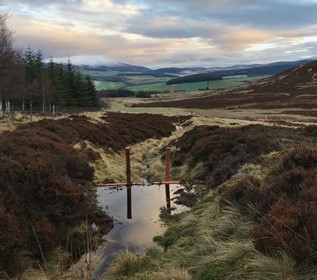
The Value of Water – Increasing resilience through Nature Based Solutions

The Covid-19 pandemic has taught us that we take many things for granted – and that includes water.
Living in Scotland, it is easy to look out the window and think “we do not have to worry about water, we have plenty of it”. Although it may feel like it rains all the time, it does not always rain when we need it to; and when it does, it comes as intense rainfall events. This has led to increasing flood events and believe it or not … droughts in Scotland.
Growing up on a farm, we were reliant on our own natural spring. In summer, we would face water scarcity and having a shower would become an extremely efficient operation! Meanwhile, in winter, excess water would cause soil erosion and the fields would become mud baths.
Due to climatic uncertainties, a growing population and changes in land use we now face an increasing exposure to flood and drought risk. The UK Climate Projection 2018 report predicts that the UK will experience warmer, wetter winters and drier, hotter summers. Currently, flood damage costs in Scotland are estimated at ~£250m per year. Furthermore, the National Audit Office raised concerns that the UK’s total available water supply will reduce by 7% by 2045.
Previously, hard engineering approaches have been used to deal with these environmental ills. However, has nature provided the solution all along?

runoff and replenish groundwater storage
On the 5th anniversary of the Paris Climate Agreement, Nature Based Solutions are now emerging as a key flood and drought risk management strategy … But what are Nature Based Solutions? They are interventions inspired by the processes and functioning of nature, which aim to resolve environmental ills (e.g. flooding). This can include flood storage ponds/areas or restoring/protecting forests. In the context of flooding, Nature Based Solutions aim to “slow the flow” allowing excess rainwater to be stored in the catchment and then soak into the ground. This minimises the volume of water travelling downstream before it reaches settlements. Therefore, both flood risk and the need for expensive hard engineering approaches is reduced. The UK government has identified Nature Based Solutions as a key strategy for flood mitigation, setting aside £15 million in investment. Although primarily used for flood mitigation in the UK (see Natural Flood Management Network Scotland for examples), Nature Based Solutions provide wider benefits such as drought management, improved water quality and habitat creation for wildlife.
Though a relatively new concept for environmental management in the UK, Nature Based Solutions have been utilised for many years in India. The Rajasthan region has a long history of rainwater harvesting, using Nature Based Solutions such as Johads (storage ponds). These features store runoff, which then soak into ground and replenish aquifers. This has been found to improve community resilience by increasing crop yields and accessibility to water (see The Flow Partnership).
As we already know, water is the most essential natural resource. The value of water is only going to become more significant as we face future water scarcity and flooding issues. Nature Based Solutions can provide a sustainable cure for many environmental ills, dealing with the issues at the source rather than fixing the symptoms.
In order to protect our most important natural resource, maybe we should look to nature for help.
Martyn Roberts, University of Aberdeen
